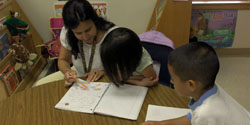| Assessment Method |
Purpose |
When Used |
Instrument |
| Examining Learner Work |
Examining learner work reveals the nature and extent of learner understanding, clarifies learning expectations for learners, and provides opportunities to assess the quality of a previously taught task or plan and the implications for teaching practice. |
Before planning the project, look at learner work and ask: What skills, knowledge, and understandings do the learners demonstrate? What is the evidence? What are the misconceptions? Are there any patterns or trends to focus on? |
- Samples of work and assessments from different learners
- Samples of one learner over time
- Data from tests
|
| Graphic Organizers |
Graphic organizers provide a visual representation of learner’s current conceptual understanding and thinking processes and illuminate preconceptions. |
At the beginning of a project elicit information from learners by creating a graphic organizer on a chart to get an accurate idea of learners’ prior knowledge. Provide organizers for individual learner use throughout the project. |
|
| Know-Wonder-Learn (K-W-L) Charts |
K-W-L charts provide a structure for learners to think about what they know about a topic, note what they want to know, and finally record what has been learned and is yet to be learned. They allow learners to make personal connections before the content is deeply explored. |
Use at the beginning of a project, during a class discussion, or individually in journals. |
- Topic on chart paper or electronic white board
- Journal
|
| Think-Pair-Share |
Think-Pair-Share asks learners to first think about a question, then to pair with someone and verbally share their response, and finally to summarize their ideas for the benefit of the entire class. This helps learners organize prior knowledge and brainstorm questions. |
Use at the beginning of a project and during class discussions. |
- Question or prompt
- Form for recording summaries and questions
|
| Brainstorming |
Learners generate terms and ideas related to a topic and form creative connections between prior knowledge and new possibilities. |
Use at the beginning of project, during a class discussion, individually, or in small groups. |
- Topic on chart paper or electronic white board
|
 Assessing Projects : Using Assessment to Improve Teaching and Learning
Assessing Projects : Using Assessment to Improve Teaching and Learning 
